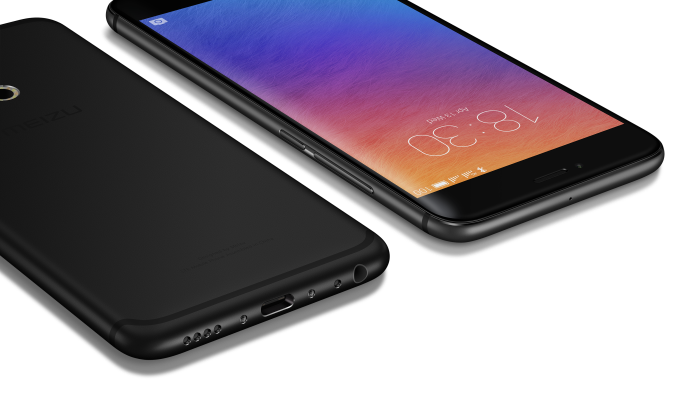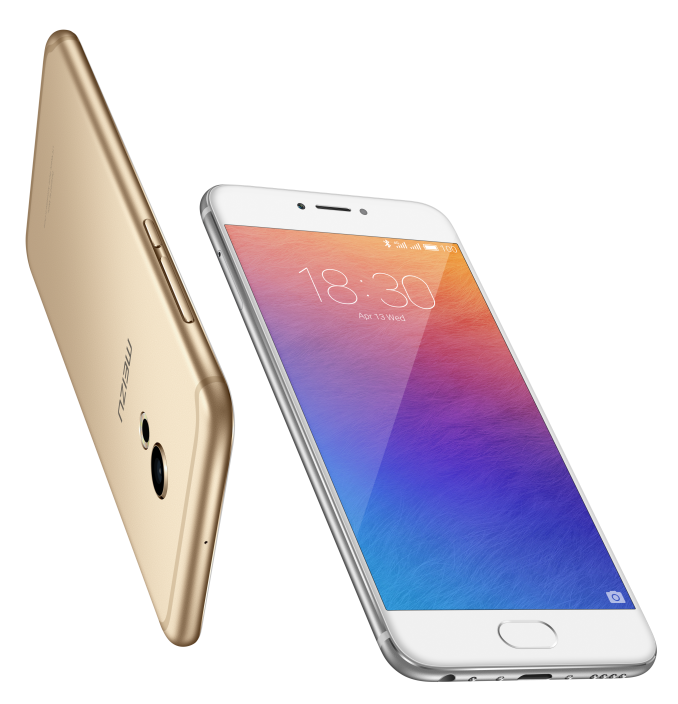Meizu Announces New PRO 6
by Andrei Frumusanu on April 13, 2016 5:30 AM EST- Posted in
- Smartphones
- Mobile
- Meizu
- PRO 6

Today Meizu launches the new PRO 6. The company had launched the PRO 5 only last September so this is a significant change in the release-schedule of the PRO series as we see the new unit come a mere 7 months after its predecessor. The "Pro" series initially debuted with the MX4Pro which we reviewed last year, since then Meizu has dropped the MX name to better differentiate between the "premium" PRO models and the more mainstream MX lineup. The PRO 6 in some ways continues where the PRO 5 left off, but at the same time makes some larger changes in terms of form-factor and component choices.
| Meizu PRO Series Specifications | ||
| Meizu PRO 6 | Meizu PRO 5 | |
| SoC | MediaTek Helio X25 2x A72 @ 2.5GHz 4x A53 @ 2.0GHz 4x A53 @ 1.4GHz Mali T880MP4 @ 850MHz |
Samsung Exynos 7420 4x A57 @ 2.1GHz 4x A53 @ 1.5GHz Mali T760MP8 @ 770MHz |
| RAM | 4GB LPDDR3-1866 | 3 / 4GB LPDDR4-3200 |
| NAND | 32 / 64GB eMMC 5.1 NAND | 32 / 64GB UFS 2.0 + microSD |
| Display | 5.2” 1080p AMOLED | 5.7” 1080p AMOLED |
| Modem | 2G/3G/4G LTE Cat 6 (Integrated MediaTek SoC Modem) |
2G/3G/4G LTE Cat 6 |
| Dimensions | 147.7 (h) x 70.8 (w) x 7.25 (d) mm 160g |
156.7 (h) x 78 (w) x 7.5 (d) mm 168g |
| Camera | Rear Camera 21.16MP ( 5444 x 4016 ) Sony IMX230 1/2.4" 1.12µm pixels F/2.2 aperture w/ Laser & Phase Detection focus |
Rear Camera 21.16MP ( 5444 x 4016 ) Sony IMX230 1/2.4" 1.12µm pixels F/2.0 aperture w/ Laser & Phase Detection focus w/ Dedicated Samsung ISP |
| Front Facing Camera 5MP 1.4µm pixels F/2.0 aperture |
Front Facing Camera 5MP 1.4µm pixels F/2.0 aperture |
|
| Battery | 2560mAh (~9.85 Whr) | 3050mAh (~11.74 Whr) |
| Launch OS | Android 6.0 with FlyMe 5.6 | Android 5.1 with FlyMe 5.0 |
| Connectivity | 802.11a/b/g/n 2.4 & 5GHz BT 4.1, GPS/GNSS USB-C 3.1 |
802.11 b/g/n/ac 2.4 & 5GHz BT 4.1 + BLE, GPS/GNSS USB-C |
| SIM Size | NanoSIM + NanoSIM | NanoSIM |
| Launch MSRP | 32GB RMB ¥2499 (USD~386, ~340€, ~271£) |
3GB/32GB RMB ¥2799 (USD~438, ~393€) |
| 64GB RMB ¥2799 (USD~432, ~381€, ~304£) |
4GB/64GB RMB ¥3099 (USD~485, ~435€) |
|
The PRO 6 is quite a strange successor as at first glance the upgrades aren't quite evident. The PRO 6 replaces the traditional Samsung LSI Exynos SoCs with MediaTek's Helio X25. The X25 is exclusive to the PRO 6 and essentially is an X20 with the dual-core A72 cluster clocked in at 2.5GHz instead of 2.3GHz. The three-cluster design also features a quad-core A53 at 2.0GHz as well as a low-power A53 quad-core at 1.4GHz. On the GPU side we see a Mali T880MP4 at 850MHz. Main memory is 4GB of LPDDR3 running at 933MHz.
The SoC choice puts the PRO 6 in a weird position when compared to the PRO 5 as except for single-thread performance the X25 should theoretically represent a downgrade compared to the Exynos 7420 in last year's model. It's especially in terms of power efficiency where this raises question as we move from a 14nm FinFET design back to a 20nm planar manufacturing process, so I hope that Meizu's SoC choice doesn't negatively impact power efficiency of the phone.
In terms of design the PRO 6 doesn't differ too much from the PRO 5, that is until one takes into account the form-factor of the new model. On the front we see very little distiguishable differences - except for the fact that Meizu downgraded the screen size from 5.7" down to 5.2" marking a departure from the larger "phablet" size. The display panel remains a 1080p AMOLED sourced by Samsung Display.
A first for Meizu is now the inclusion of a pressure sensitive touchscreen module which Meizu calls 3D Press. As we've seen in Apple's latest iPhones or even Huawei's implementation on the Mate S, this is a hardware feature that will undoubtedly depend on the software framework and applications to expose and take advantage of the new functionality. Meizu here might have some better lee-way in terms of Android customization when compared to other vendors who have to adhere to Google's CTS requirements, so it will be interesting to see what Meizu was able to come up with in the latest FlyMe 5.6 OS.
The reduction in size also has an impact on the integrated battery's capacity as we move from a 3050mAh cell down to a 2560mAh unit. Oddly enough, the device only loses 8g and remains relatively heavy for a 5.2" device, coming at 160g.
The main camera remains unchanged from the PRO 5, we find the same 21.16MP Sony IMX230 module featuring both PDAF as well as Laser auto-focus. We see a downgrade in the optics as the PRO 6 features an aperture of F/2.2 compared to the PRO 5's F/2.0 lens. The front-facing camera remains a 5MP unit with 1.4µm pixels.
The PRO 6 comes in 32GB or 64GB models RMB ¥2499 (USD~386, ~340€, ~271£) and RMB ¥2799
(USD~432, ~381€, ~304£) with pre-orders starting now.












29 Comments
View All Comments
hyno111 - Wednesday, April 13, 2016 - link
They use "USB 3.1 Gen 1", which means USB 3.0.solipsism - Wednesday, April 13, 2016 - link
But does that translate into actual throughput for reading and (mostly) writing data to the NAND beyond what USB 2.0 speeds offer?jjj - Wednesday, April 13, 2016 - link
No mention of the 10 LED flash, that's the most interesting bit as nobody else does it.The GPU is at 850MHz for the X25 while the X20 is at 780MHz not 700MHz- they updated the specs since launch. http://mediatek-helio.com/x20/
On the SoC side you might be rushing when saying that efficiency decreases. 2+4+4 vs 4+4 is pretty different and you got the A72 upside. Hope you get your hands on it and take a look at how it throttles.
Any chance you might be able to share if you've seen the Adreno 530 bellow 214MHz in gaming? That's the lowest i have seen it so far, wondering if it goes even lower.
ToTTenTranz - Wednesday, April 13, 2016 - link
Are you sure there's no WiFi ac, only n?Well.. at least they adjusted the price accordingly..
The 64GB Pro 6 could be an attractive phone if found at 350-400€ in euroland.
Ian Cutress - Wednesday, April 13, 2016 - link
Can confirm, press materials show a/b/g/n, no ac.jjj - Wednesday, April 13, 2016 - link
The official specs do list ac http://www.meizu.com/products/pro6/spec.htmlIan Cutress - Wednesday, April 13, 2016 - link
Confirmed with MEIZU direct. It should be 802.11ac.It's worrying how many non-ac devices still exist that this isn't automatically flagged as erroneous in the press materials.
jjj - Wednesday, April 13, 2016 - link
The Mediatek Helio P10 ( A53 at up to 2GHz) doesn't have integrated ac and plenty of budget devices lack ac. The Meizu M3 Note that recently launched at 799CNY doesn't have it. To be fair , at a global level , how many users have wifi ac, most users don't even know what that is. Public and enterprise wifi should have very low penetration for 5GHz. I was assuming that even 100-150$ China phones have it by now but a few months ago realized that's not the case and many lack wifi ac.halcyon - Wednesday, April 13, 2016 - link
eMMC 5.1 (not UFS 2.0) = downgrade2560mAh battery (vs old 3050mAh) = downgrade
NO microSD slot = downgrade
Decent mid-leaguer, but disapointing.
jordanclock - Wednesday, April 13, 2016 - link
Plus a regression from DDR4-3200 to DDR3-1866. That's a serious drop in memory bandwidth from 25.6GB/s to 14.9GB/s. The GPU might be lower core count but I feel like a 40% drop in bandwidth is going hit it hard.